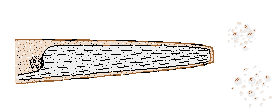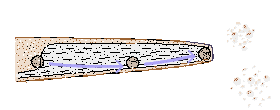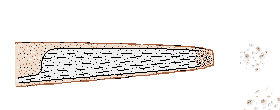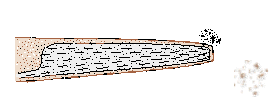
by Rosemarie Arbur, Oregon, US |

by Rosemarie Arbur, Oregon, US |
| A large
ciliate that swims smoothly and rests quietly in place for moments at a
time, Spirostomum rewards its observer by being always interesting.
About a week after I brought home water and many tufts of filamentous green
algae (Stigeoclonium) from the sunny shallows of a lake, Spirostomum
began to appear, joining the Stentor and Paramecium that
abounded in my jar of water. Not having seen Spirostomum for at
least six months, and after having succeeded in getting one from jar to
slide, I decided on a thorough reacquaintance.
[For simplicity and clarity, my drawings leave out body cilia and, after the first, Spirostomum's macronucleus; I've also omitted the myonemes visible in the anterior two-thirds of the body and the membranes surrounding food vacuoles where they're not relevant. Colors here are just a bit exaggerated; the white spots are very small, bright granules that with the even smaller, darker ones give Spirostomum's cytoplasm its characteristic visual texture.] |
 |
| This Spirostomum is about 450 µm long, with a peristome (left) that does not reach even the midpoint of its body. (Spirostomum ambiguum, the "representative" species, exceeds 1 mm and has a longer peristome, three-quarters of its body length.) The water-expelling vesicle or contractile vacuole (right) is relatively long, with a very long canal, and its transparency makes the myonemes adjacent to it easily visible as longitudinal lines. This Spirostomum species, most likely S. teres, has a single, oval macronucleus near the center of its body; as I adjusted focus, I couldn't always see it. But I did see food vacuoles, large and small: the darker bodies in cytoplasm. |
 |
| It would hardly be a Spirostomum if it didn't perform its most famous behavior: contracting itself faster than any other living entity or cell. Like others I've seen, this specimen makes itself almost diamond-shaped when it pulls its front and rear ends toward each other. |
 |
| In seconds, it resumes its previous length and leisurely cruises about, happily (for me) staying in same general area. I notice a suspicious-looking clump, as big as a Cyclidium (25 µm diam), near its rear end. Spirostomum seems to be towing it. |
 |
| With their moderately soft, flexible pellicles, swimming Spirostomum often bend around bits of algae and other obstacles they encounter. This Spirostomum is bending for no discernible reason, folding its anterior half almost back on itself. There are two suspicious-looking clumps now. |
 |
| After its acrobatics, Spirostomum resumes its normal shape. Then it empties its water-expelling vesicle, twisting the posterior third of its body and presenting this curious profile. I've seen other Spirostomum empty this vesicle by compressing it from "top" (as seen in preceding drawing) to "bottom," without much alteration of "top" edge of pellicle. The view here suggests that this Spirostomum is compressing the vesicle in three dimensions (it's shortening the vesicle slightly, and it's decreasing the diameter of a cylinder, not just the width of a rectangular oval). The clumps seem to dissolve as they're left behind; but new ones, not so diffuse, appear. |
| It finally occurs to me that the suspicious-looking clumps are feces being expelled at Spirostomum's posterior end. Well, I think, watching food vacuoles form is an educational exercise for microscopists; why not watch the rest of digestive process? |
 |
| Spirostomum
forms food vacuoles that are quite large initially. Ingested material passes
through the mouth or cytostome (at the end of the peristome) into a membranous
sac; when enough has been ingested or when the sac reaches a sufficient
size, the membrane pinches shut to form a discrete vacuole. Digestion occurs
while the vacuole moves about, circulating with the cell's other contents.
As digestion proceeds, the food vacuole becomes smaller.
As best I could see, the large food vacuoles don't move into the vicinity of the water-expelling vesicle; they move as the arrows show, rather slowly, and may make several circuits of the anterior two-thirds of Spirostomum's body. Digestion and absorption of the contents take several minutes before the vacuole reaches the size and location of the small round one above. |
 |
| When digestion of its contents is complete and the shrunken food vacuole approaches the front end of the water-expelling vesicle, the movement of the vacuole speeds up quite noticeably. |
 |
| It moves along and beyond the water-expelling vesicle, from near its anterior end (left) to the organism's posterior extremity (right), in less than one second. |
 |
| After a minute, the membrane that surrounded the contents of the food vacuole dissolves. |
 |
| And most of the undigested matter is expelled through an anal pore. |
 |
| Some minutes later, Spirostomum curls about itself, this time more tightly than before; its anterior tip pushes hard against the end of its peristome, and the folded-over portion of its body flattens. The large food vacuole remains near the fold. Possibly, it does not move toward the rear because the organism's body is kinked like a garden hose. Spirostomum holds this posture for about five minutes. |
 |
| Then all tension in the body relaxes, and the organism is dead. Both water- and food vacuoles seem larger than before, the latter appearing yellowish. Because the extreme folding seems to have prevented that food vacuole from moving on, the way a "twisted gut" can bring a horse's great digestive system to a fatal standstill, I wonder if this Spirostomum died of colic. Putting that grim humor aside (seeing micro-critters die upsets me), I also wonder about Spirostomum's myonemes. Dead, its body is shorter than when it was alive; can it be that the (proto-"muscular") tension in the myonemes not only contracts the organism periodically to a fraction of its usual length but also, as a normal, most-of-the-time process, actively stretches Spirostomum to its characteristic size? |
All comments to the author Rosemarie Arbur are welcomed.
Please report any Web problems or
offer general comments to the
Micscape
Editor,
via the contact on current Micscape
Index.
Micscape is the on-line monthly magazine
of the Microscopy UK web
site at Microscopy-UK
WIDTH=1